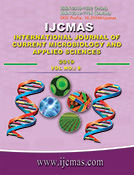


 National Academy of Agricultural Sciences (NAAS)
National Academy of Agricultural Sciences (NAAS)

|
PRINT ISSN : 2319-7692
Online ISSN : 2319-7706 Issues : 12 per year Publisher : Excellent Publishers Email : editorijcmas@gmail.com / submit@ijcmas.com Editor-in-chief: Dr.M.Prakash Index Copernicus ICV 2018: 95.39 NAAS RATING 2020: 5.38 |
Remote sensing has several advantages in the field of agronomical research purpose. The assessment of agricultural crop canopies has provided valuable insights in the agronomic parameters. Remote sensing play a significant role in crop classification, crop monitoring and yield assessment. The use of remote sensing is necessary in the field of agronomical research purpose because they are highly vulnerable to variation in soil, climate and other physico- chemical changes. The monitoring of agricultural production system follows strong seasonal patterns in relation to the biological life cycle of crops. All these factors are highly variable in space and time dimensions. Moreover, the agricultural productivity can change within short time periods, due to unfavourable growing conditions. Monitoring of agricultural systems should be followed in timely. Remote sensing are important tools in timely monitoring and giving an accurate picture of the agricultural sector with high revisit frequency and high accuracy. For sustainable agricultural management, all the factors which are influencing the agricultural sector need to be analysed on spatio-temporal basis. The remote sensing along with the other advanced techniques such as global positioning systems and geographical information systems are playing a major role in the assessment and management of the agricultural activities. These technologies have many fold applications in the field of agriculture such as crop acreage estimation, crop growth monitoring, soil moisture estimation, soil fertility evaluation, crop stress detection, detection of diseases and pest infestation, drought and flood condition monitoring, yield estimation, weather forecasting, precision agriculture for maintaining the sustainability of the agricultural systems and improving the economic growth of the country.
 |
 |
 |
 |
 |